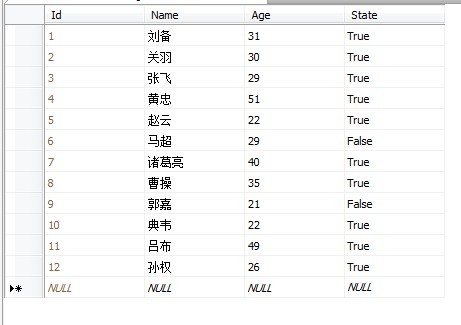NHibernate 数据查询之QueryOver<T>
一、限制运算符
Where:筛选序列中的项目
WhereNot:反筛选序列中的项目
二、投影运算符
Select:创建部分序列的投影
SelectMany:创建部分序列的一对多投影
三、分区运算符(分页常用到)
Skip:返回跳过指定数目项目的序列
SkipWhile:返回跳过不满足表达式项目的序列
Take:返回具有指定数目项目的序列
TakeWhile:返回具有满足表达式项目的序列
四、排序运算符
OrderBy:以升序按值排列序列
OrderByDescending:以降序按值排列序列
ThenBy:升序排列已排序的序列
ThenByDescending:降序排列已排序的序列
Reverse:颠倒序列中项目的顺序(用于操作集合)
五、分组运算符
GroupBy:按指定分组方法对序列中的项目进行分组
六、设置运算符
Distinct:返回无重复项目的序列
Except:返回代表两个序列差集的序列(用于操作集合)
Intersect:返回代表两个序列交集的序列(用于操作集合)
Union:返回代表两个序列交集的序列(用于操作集合)
七、转换运算符
Cast:将序列中的元素转换成指定类型
OfType:筛选序列中指定类型的元素
ToArray:从序列返回一个数组
ToDictionary:从序列返回一个字典
ToList:从序列返回一个列表
ToLookup:从序列返回一个查询
ToSequence:返回一个IEnumerable序列
八、元素运算符
DefaultIfEmpty:为空序列创建默认元素(用于操作集合)
ElementAt:返回序列中指定索引的元素(用于操作集合)
ElementAtOrDefault:返回序列中指定索引的元素,或者如果索引超出范围,则返回默认值(用于操作集合)
First:返回序列中的第一个元素
FirstOrDefault:返回序列中的第一个元素,或者如果未找到元素,则返回默认值
Last:返回序列中的最后一个元素(用于操作集合)
LastOrDefault:返回序列中的最后一个元素,或者如果未找到元素,则返回默认值(用于操作集合)
Single:返回序列中的单个元素
SingleOrDefault:返回序列中的单个元素,或者如果未找到元素,则返回默认值
九、生成运算符
Empty:生成一个空序列
Range:生成一个指定范围的序列
Repeat:通过将某个项目重复指定次数来生成一个序列
十、限定符
All:确定序列中的所有项目是否满足某个条件
Any:确定序列中是否有任何项目满足条件
Contains:确定序列是否包含指定项目
十一、聚合运算符
Aggregate:对序列执行一个自定义方法
Average:计算数值序列的平均值
Count:返回序列中的项目数(整数)
LongCount:返回序列中的项目数(长型)
Min:查找数字序列中的最小数
Max:查找数字序列中的最大数
Sum:汇总序列中的数字
十二、连接运算符
Concat:将两个序列连成一个序列
十三、联接运算符
GroupJoin:通过归组将两个序列联接在一起
Join:将两个序列从内部联接起来
我新建了一个张表,并添加了十几条数据。

在NHibernate中,linq查询通过session.QueryOver<T>()创建。我们先来看看NHibernate本身自带的Linq提供的操作符。
1、And
public IList<Person_Model> Select()
{
IList<Person_Model> list = session.QueryOver<Person_Model>().And(m => m.State).List(); //查询所有state字段为True的记录
NHibernateHelper.CloseSession();
return list;
}
以上生成的SQL语句为
exec sp_executesql N'SELECT this_.Id as Id1_0_, this_.name as name1_0_, this_.age as age1_0_, this_.state as state1_0_ FROM Person this_ WHERE this_.state = @p0',N'@p0 bit',@p0=1
可以看到And实际上相当于一条Where语句了。条件为True的返回。
我们把And换成Where再来看看生成的SQL语句。
exec sp_executesql N'SELECT this_.Id as Id1_0_, this_.name as name1_0_, this_.age as age1_0_, this_.state as state1_0_ FROM Person this_ WHERE this_.state = @p0',N'@p0 bit',@p0=1
呵呵,没有区别。留待
2、AndNot
public IList<Person_Model> Select()
{
IList<Person_Model> list = session.QueryOver<Person_Model>().AndNot(m => m.State).List(); //查询所有state字段等于false的记录
NHibernateHelper.CloseSession();
return list;
}
我们来看看生成的SQL语句
exec sp_executesql N'SELECT this_.Id as Id1_0_, this_.name as name1_0_, this_.age as age1_0_, this_.state as state1_0_ FROM Person this_ WHERE not (this_.state = @p0)',N'@p0 bit',@p0=1
留意到它只比And操作符的区别在于在where条件后加了个not()
3、AndRestrictionOn
AndRestrictionOn的中文意思是,添加限制条件。
public IList<Person_Model> Select()
{
IList<Person_Model> list = session.QueryOver<Person_Model>().AndRestrictionOn(m => m.Name).IsLike("诸",NHibernate.Criterion.MatchMode.Anywhere).List();
NHibernateHelper.CloseSession();
return list;
}
第二个参数IsLike的第二个参数NHibernate.Criterion.MatchMode.Anywhere是一个枚举,指示百分号应该添加到哪里?
生成的SQL语句如下:
exec sp_executesql N'SELECT this_.Id as Id1_0_, this_.name as name1_0_, this_.age as age1_0_, this_.state as state1_0_ FROM Person this_ WHERE this_.name like @p0',N'@p0 nvarchar(4000)',@p0=N'%诸%'
4、JoinAlias
JoinAlias主要用于连接表并添加别名,对应的SQL字句是Join,根据Person查Country
public IList<Person_Model> Select()
{
Country_Model country = null; //必须定义一个用于别名的Country_Model,且必须为null
IList<Person_Model> list = session.QueryOver<Person_Model>().JoinAlias(m => m.Country, () => country).List();
NHibernateHelper.CloseSession();
return list;
}
生成的sql语句为
SELECT this_.Id as Id0_1_, this_.name as name0_1_, this_.age as age0_1_, this_.state as state0_1_, this_.CountryId as CountryId0_1_, country1_.CountryId as CountryId1_0_, country1_.CountryName as CountryN2_1_0_ FROM Person this_ inner join Country country1_ on this_.CountryId=country1_.CountryId
该查询会把Country的信息也查出来。
其次,JoinAlias还可以支持第三个参数,其用于指定外连接的类型。
例如将JoinAlias改为:
public IList<Person_Model> Select()
{
Country_Model country = null; //必须定义一个用于别名的Country_Model,且必须为null
IList<Person_Model> list = session.QueryOver<Person_Model>().JoinAlias(m => m.Country, () => country,NHibernate.SqlCommand.JoinType.LeftOuterJoin).List();
NHibernateHelper.CloseSession();
return list;
}
则,生成的SQL语句为:
SELECT this_.Id as Id0_1_, this_.name as name0_1_, this_.age as age0_1_, this_.state as state0_1_, this_.CountryId as CountryId0_1_, country1_.CountryId as CountryId1_0_, country1_.CountryName as CountryN2_1_0_ FROM Person this_ left outer join Country country1_ on this_.CountryId=country1_.CountryId
NHibernate.SqlCommand.JoinType是一个枚举类型,其支持的值有
枚举值 对应的SQL
FullJoin full outer join
InnerJoin inner join
LeftOuterJoin left outer join
RightOuterJoin right outer join
None 不连接,不连接还要这个参数干嘛?
5、JoinQueryOver
public IList<Person_Model> Select()
{
IList<Person_Model> list = session.QueryOver<Person_Model>().OrderBy(p => p.Age).Desc.Inner.JoinQueryOver<Country_Model>(o => o.Country).List();
NHibernateHelper.CloseSession();
return list;
}
生成的SQL语句为
SELECT this_.Id as Id0_1_, this_.name as name0_1_, this_.age as age0_1_, this_.state as state0_1_, this_.CountryId as CountryId0_1_, country_mo1_.CountryId as CountryId1_0_, country_mo1_.CountryName as CountryN2_1_0_ FROM Person this_ inner join Country country_mo1_ on this_.CountryId=country_mo1_.CountryId ORDER BY this_.age desc
还不知道与JoinAlias有什么区别,除了返回值类型,唉。这个东西好他妈的难。
6、OrderBy
Order主要用于排序,相当于SQL语句里面的order by。
public IList<Person_Model> Select()
{
IList<Person_Model> list = session.QueryOver<Person_Model>().OrderBy(p => p.Age).Desc.List(); //按照年龄降序排序
NHibernateHelper.CloseSession();
return list;
}
生成的SQL语句为
SELECT this_.Id as Id0_0_, this_.name as name0_0_, this_.age as age0_0_, this_.state as state0_0_, this_.CountryId as CountryId0_0_ FROM Person this_ ORDER BY this_.age desc
其中OrderBy方法后面能跟的属性有两个,分别是Asc与Desc与数据库的SQL语句对应相同意思。
7、OrderByAlias
8、Lock
9、Select
告知NHibernate你想要查询的是什么东西。
IList<int> list1 = session.QueryOver<Person_Model>().Select(p => p.Age).List<int>(); //获取所有年龄的IList集合
NHibernateHelper.CloseSession();
return list;
生成的SQL语句为
SELECT this_.age as y0_ FROM Person this_
10、ThenBy
与SQL语句中的then by同义。
public IList<Person_Model> Select()
{
IList<Person_Model> list = session.QueryOver<Person_Model>().OrderBy(p => p.Age).Asc.ThenBy(p => p.Id).Desc.List();
NHibernateHelper.CloseSession();
return list;
}
生成的SQL语句为
SELECT this_.Id as Id0_0_, this_.name as name0_0_, this_.age as age0_0_, this_.state as state0_0_, this_.CountryId as CountryId0_0_ FROM Person this_ ORDER BY this_.age asc, this_.Id desc
11、Where
添加where条件,与SQL语句同义。
public IList<Person_Model> Select()
{
IList<Person_Model> list = session.QueryOver<Person_Model>().Where(p => p.Age > 50).List();
NHibernateHelper.CloseSession();
return list;
}
生成的SQL语句为
exec sp_executesql N'SELECT this_.Id as Id0_0_, this_.name as name0_0_, this_.age as age0_0_, this_.state as state0_0_, this_.CountryId as CountryId0_0_ FROM Person this_ WHERE this_.age > @p0',N'@p0 int',@p0=50
12、WhereNot
添加where条件,只是前面加了个Not。
public IList<Person_Model> Select()
{
IList<Person_Model> list = session.QueryOver<Person_Model>().WhereNot(p => p.Age > 50).List();
NHibernateHelper.CloseSession();
return list;
}
生成的SQL语句为
exec sp_executesql N'SELECT this_.Id as Id0_0_, this_.name as name0_0_, this_.age as age0_0_, this_.state as state0_0_, this_.CountryId as CountryId0_0_ FROM Person this_ WHERE not (this_.age > @p0)',N'@p0 int',@p0=50
13、Skip
跳过指定数量的记录
public IList<Person_Model> Select()
{
IList<Person_Model> list = session.QueryOver<Person_Model>().Skip(5).List();
NHibernateHelper.CloseSession();
return list;
}
生成的SQL语句为
exec sp_executesql N'SELECT TOP (2147483647) Id0_0_, name0_0_, age0_0_, state0_0_, CountryId0_0_ FROM (SELECT this_.Id as Id0_0_, this_.name as name0_0_, this_.age as age0_0_, this_.state as state0_0_, this_.CountryId as CountryId0_0_, ROW_NUMBER() OVER(ORDER BY CURRENT_TIMESTAMP) as __hibernate_sort_row FROM Person this_) as query WHERE query.__hibernate_sort_row > @p0 ORDER BY query.__hibernate_sort_row',N'@p0 int',@p0=5
14、Take
获取指定数量的记录,与Skip配合使用是经常用到的分页效果。
public IList<Person_Model> Select()
{
IList<Person_Model> list = session.QueryOver<Person_Model>().Take(5).List();
NHibernateHelper.CloseSession();
return list;
}
生成的SQL语句为
exec sp_executesql N'SELECT TOP (@p0) this_.Id as Id0_0_, this_.name as name0_0_, this_.age as age0_0_, this_.state as state0_0_, this_.CountryId as CountryId0_0_ FROM Person this_',N'@p0 int',@p0=5
15、RowCount()
统计符合条件的记录,相当于Select Count(*) from...
int count = session.QueryOver<Person_Model>().RowCount();
NHibernateHelper.CloseSession();
生成的SQL语句为
SELECT count(*) as y0_ FROM Person this_
16、RowCountInt64
也是统计记录,与RowCount没什么区别,只是返回的记录是long类型的。
long count = session.QueryOver<Person_Model>().RowCountInt64();
NHibernateHelper.CloseSession();
生成的SQL语句为
SELECT count(*) as y0_ FROM Person this_
17、SingleOrDefault
返回符合条件的第一条记录,当为空是,返回一个各属性为null的对应类型的对象。
Person_Model p = session.QueryOver<Person_Model>().Where(m => m.Age == 10).SingleOrDefault();
NHibernateHelper.CloseSession();
生成的SQL语句为
exec sp_executesql N'SELECT this_.Id as Id0_0_, this_.name as name0_0_, this_.age as age0_0_, this_.state as state0_0_, this_.CountryId as CountryId0_0_ FROM Person this_ WHERE this_.age = @p0',N'@p0 int',@p0=10
18、Future
Future()与List()的区别在于Future返回的是IEnumerable<>集合,而List()返回的是IList()。
IEnumerable<Person_Model> list1 = session.QueryOver<Person_Model>().Where(m => m.Age > 10).Future();
NHibernateHelper.CloseSession();
与SQL语句无关
19、List
List()将结果集合封装为IList()接口集合返回。
IList<Person_Model> list = session.QueryOver<Person_Model>().WhereRestrictionOn(p => p.Age).IsIn(ints).List();
NHibernateHelper.CloseSession();
与SQL语句无关。
20、FutureValue()
IFutureValue<Person_Model> list1 = session.QueryOver<Person_Model>().WhereRestrictionOn(p => p.Age).IsIn(ints).FutureValue();
Person_Model p1 = list1.Value;
FutureValue()这是一个非常简单的接口,里面就一个泛型的Value属性,也就是说.FutureValue()这个东西只是装载了一个对应查询类型的对象而已。
与SQL语句无关。
21、WhereRestrictionOn
这个东西与前面说的AdnRestrictionOn是一样的,也是可以添加条件啥乱七八糟的。
IEnumerable<Person_Model> list1 = session.QueryOver<Person_Model>().WhereRestrictionOn(p => p.Age).IsIn(ints).Future();
NHibernateHelper.CloseSession();
生成的SQL代码为:
exec sp_executesql N'SELECT this_.Id as Id0_0_, this_.name as name0_0_, this_.age as age0_0_, this_.state as state0_0_, this_.CountryId as CountryId0_0_ FROM Person this_ WHERE this_.age in (@p0, @p1, @p2)',N'@p0 int,@p1 int,@p2 int',@p0=20,@p1=25,@p2=31
